WHAT'S NEW ACROSS THE WORLD
| What's New ©by
Laif DeMason
Summer is upon us with its long days and warm
weather. Interest in all types of cichlids has been gaining speed over
the last several months, and the usual slowdown in summer sales may not
be as marked, compared to the last two years. Collectors and exporters
in the various exporting nations in West Africa seem to be “all out” for
business. Various traders in Rift Lake cichlids have increasingly used
the Internet to make live fish sales. As with any product purchased “sight
unseen”, trouble may be around the corner. Novice purchasers may not know
enough to see the differences in quality and suppliers. Ask for sales references
and, more importantly, ask if the fish are actually in stock at location.
Ask for a quick digital photo of the intended purchase, not a library photo.
Rule number one is: “Buyer beware!”
Here’s “what’s new” on the cichlid scene: |
Lake Tanganyika
With the departure of a few collectors there, a scramble by the remaining
exporters has ensued to gain territory once commanded by the former companies.
Of course now, a new set of trade names are being propagated to insure
product line. Confusion and hopes for new purchases of old varieties may
be the motives. One encouraging bit of news is that new collections of
wild material from northern Congo (Zaire) are being exported via Kigoma,
Tanzania. Of course, many Tropheus varieties from northern Congo have been
farm-raised and available for many years from Burundi.
|
what's new: Lake Tanganyika
|

A “brichardi” type similar to “walteri”, Neolamprologus
splendens collected from southern Congo sports light-green facial markings. |
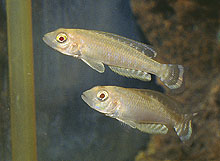
Reportedly developed in Europe, an albino form of
Lamprologus callipterus is now available. |
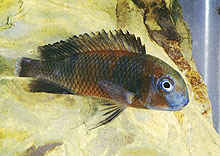
Raised and exported for years from Burundi, Tropheus
moorii “Karambe” (known as “red head”) is now being collected wild
from the eastern coastline of the Ubwari Peninsula in Congo. |
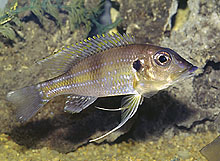
Difficult to collect in quantity, Gnathochromis
permaxillaris has been exported sporadically for ten years. Current
exports from Burundi are in larger numbers and at bargain prices. |
Lake Malawi
Collections and exports of wild material from all corners of Lake Malawi
are strong. Increased sales have also spawned an increased effort to supply
more selections and varieties. Commercial breeders also report low inventories
on many items. “Specialty” small mbuna and Aulonocara “peacock” varieties
appear to be the most popular currently.

An intermediate variety, Aulonocara stuartgranti
“Mundola Point” is a newly offered peacock form. Photo by A. Konings. |
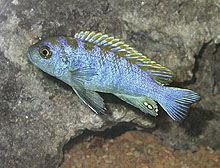
The new Cynotilapia afra “Chimate” from Tanzania
is a dwarf species which sports a bicolored dorsal fin. |
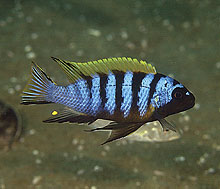
From a new reef area in the north, Metriaclima
sp. “red top Galilea” is often sold as a “zebra” variety. Photo by
A. Konings. |
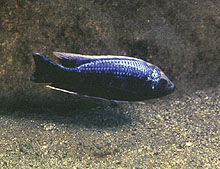
Collected from the Makonde-Nsisi area of Tanzania,
Copadichromis trewavasae is better known as red-tip or red-line
“mloto” and is again available from wild sources. |
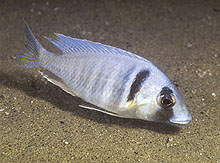
From Londo (Mozambique), Placidochromis electra
“black cheek” is an interesting item. Photo by A. Konings. |
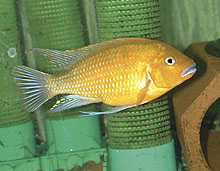
Only rarely collected, Pseudotropheus williamsi
“Makonde orange” has been exported lately from Tanzania. Photo by A.
Konings. |
West Africa
Business has been good for some West African exporters. Cameroon, Congo,
Guinea, and Nigeria have all been active of late. Surprisingly, interest
among hobbyists is also keen for these cichlid fishes. Perhaps, the novelty
of the many colorful varieties has captivated their attention. Many are
trying their hand at these new selections.
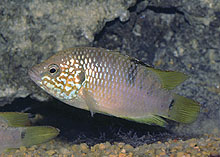
Sold as “lemon forest jewel”, this spangled-face
Hemichromis from Guinea is once again proving to be popular. |
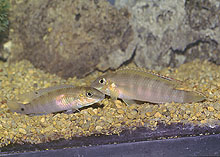
A new species, Pelvicachromis signatus, hailing
from the Kolente River (Guinea), often arrives mixed with Pel. humilis. |
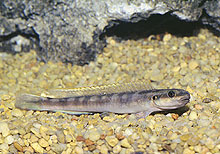
Collected and shipped from Cameroon, this species
could be Gobiocichla ethelwynnae. |
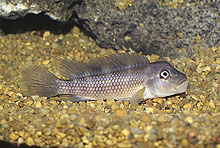
One of the few different types of buffalohead forms
shipped from the Congo River basin, Steatocranus sp. “Gombi” tends
to be a bit more elongated than related forms. |
Neotropics
The collecting season in some parts of South America is over for now.
However, there is still material shipped weekly from most countries. Popular
tank-raised dwarf cichlids, as well as species such as discus, are actively
being sold. Specialty-breeders can provide that unusual and sought-for
item that is just not found elsewhere.
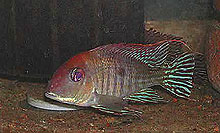
From southern Brazil, Geophagus sp. “red head
Tapajos” is a colorful form. Photo by J. Rapps. |
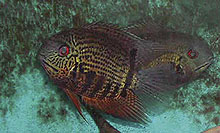
Originally from Guyana, Heros notatus is now
available. Photo by J. Rapps. |
|















